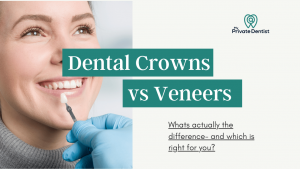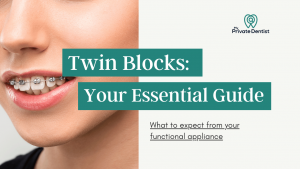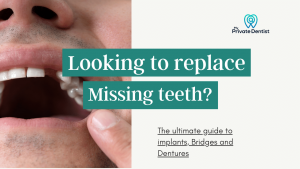These are my recommendations for choosing the best fluoride toothpastes UK 2024.
As a dentist, I know choosing a good toothpaste can make a huge difference in how healthy your teeth are.
But with so many options on the market, it’s difficult to find which one is right for you. Fluoride is by far the most important ingredient in toothpaste when it comes to preventing tooth decay.
Incorporating Oral-B Pro Expert Clean Mint Toothpaste into your daily oral care regimen will strengthen your enamel, ward off tooth decay, and uphold general oral well-being. If you have sensitive teeth, Sensodyne Repair & Protect Toothpaste can alleviate symptoms and also offers optimal defence against decay.
So how do we choose the best fluoride toothpaste. I’ve written this guide to help you.
Let’s talk about fluoride
I was looking online and saw so many toothpaste which are proud to be fluoride free and ‘natural’. As a dentist, I was disappointed to see this.
I’ve see what can happen if you use a fluoride-free toothpaste, as together with poor brushing and diet, it can contribute to numerous dental problems including cavities and tooth loss.
Fluoride in toothpaste is a wonderful intervention which will help to strengthen your enamel, prevent cavities, and it’s clinically proven over many years to do so (1).
Is fluoride safe to use?
Fluoride is found naturally in water, or in some areas added to help provide the public with oral health benefits.
It is safe to use at recommended levels in toothpaste. The confusion comes because in high levels it can be toxic if swallowed, but it’s like saying paracetamol is not safe to use, as in large quantities it can also be toxic.
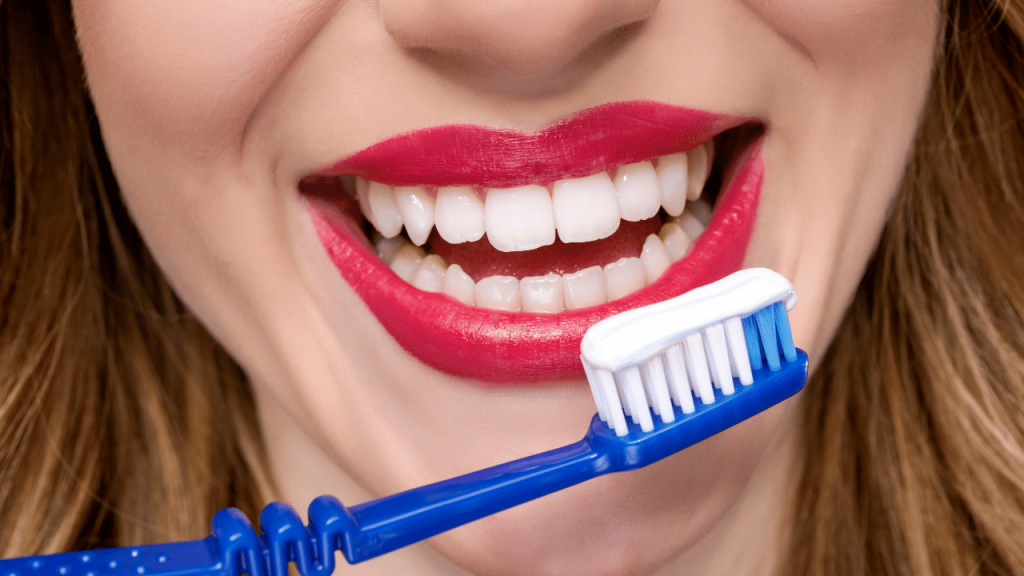
What are the safe levels?
The safe levels of fluoride are different for different ages, namely in babies, kids and adults.
See below simplified table as recommended by the NHS.
- Children below 3 years of age should brush their teeth twice a day using a smear of toothpaste containing 1,000ppm fluoride.
- For children aged 3 to 6, brushing at least twice daily with a pea-sized portion of toothpaste containing over 1,000ppm fluoride is recommended.
- As for children over 7 and adults, brushing at least twice daily with toothpaste containing 1,350-1,500ppm fluoride is advised.
How does fluoride work to strengthen teeth and prevent decay?
Fluoride works to strengthen teeth and prevent decay by forming a protective barrier on the enamel. When fluoride is present in the mouth, it is absorbed into the enamel, making it more resistant to acid attacks from plaque bacteria and sugars (1).
This process, known as remineralisation, helps repair early signs of tooth decay and reinforces the enamel, ultimately reducing the risk of cavities, pain and tooth loss.
Who does fluoride benefit?
The importance of fluoride in toothpaste extends to individuals of all ages.
Fluoride plays a vital role in strengthening tooth enamel and preventing tooth decay, making it an essential component of oral care for both children and adults.
By incorporating fluoride toothpaste into your daily oral hygiene routine, patients can benefit from its enamel-strengthening properties and its ability to combat the detrimental effects of plaque and acids, thus contributing to improved oral health and overall well-being.
While alternative toothpastes may contain components aimed at addressing sensitivity, bad breath, and staining, fluoride stands out as the most crucial ingredient for individuals at a heightened risk of decay.
What about high fluoride toothpaste?
2800ppm or 5000ppm Fluoride toothpastes are prescribed for high-risk patients who are particularly susceptible to tooth decay. These individuals may include those with a history of frequent cavities, weakened enamel, or other dental conditions that increase their susceptibility to decay.
In such cases, the use of fluoride toothpaste prescribed by a dental professional can provide targeted protection and support in combating the risk of tooth decay.
Why can’t everyone have high fluoride toothpaste?
Not everyone can have high fluoride toothpaste because excessive fluoride intake can lead to dental fluorosis, a condition characterized by discoloration and mottling of the teeth.
Therefore, the use of high fluoride toothpaste is typically limited to individuals who are at a higher risk of tooth decay and who can benefit from the targeted protection it offers.
Dental professionals assess each patient’s risk factors and oral health needs to determine the most appropriate type of toothpaste for their specific situation, ensuring that the benefits of fluoride outweigh any potential risks.
7 Top Picks for Best Fluoride Toothpaste
Overall Best Fluoride Toothpaste – Oral-B Pro Expert Clean Mint Toothpaste
Best Fluoride Toothpaste for Sensitivity – Sensodyne Repair & Protect Toothpaste
Best Fluoride Toothpaste for Whitening – Colgate Max White Expert +
Best Fluoride Toothpaste for Gum health – Colgate Periogard gum protection Toothpaste
Best SLS-Free Fluoride Toothpaste – Sensodyne Pronamel Toothpaste
Best Fluoride Toothpaste for Kids under 3 – Aquafresh Baby Toothpaste, Milk Teeth
Best Fluoride Toothpaste for Kids under 3-6 years – Punch & Judy Kids Toothpaste
Overall Best Fluoride Toothpaste
Oral-B Pro Expert Clean Mint Toothpaste
Why our dentists recommend this toothpaste:
This is the toothpaste I use myself. It’s just a great all rounder, with the perfect fluoride levels. It contains both sodium fluoride to help prevent decay, and stannous fluoride which had numerous benefits for sensitivity by blocking exposed dentine tubules(3) and improves gum health by inhibiting plaque build up (4).
The slightly gritty texture; that’s the Sodium Hexametaphosphate crystals that help to remove stains and prevent tartar build-up.
Using a pea-sized amount of toothpaste this means that it should last around 2 months which is around 5p per day.
Pros: Tastes great, fresh, excellent protection, good stain removal
Cons: Not the cheapest. Cool mint “cinnamon” flavour not for everyone. Contains SLS.
Best Fluoride Toothpaste for Sensitivity
Sensodyne Repair & Protect Toothpaste
Why our dentists recommend this toothpaste:
The symptom of general sensitivity to cold is frequently observed in my clinic, often resulting from gum recession due to aggressive manual toothbrushing. In such cases, I consistently recommend Sensodyne Repair and Protect to my patients.
Based on the feedback I received after providing samples to my patients, many have found it to be highly effective.
The active ingredient in this toothpaste, NovaMin, works to reduce sensitivity by forming a protective layer over exposed dentin, effectively blocking the tubules and preventing cold stimuli from reaching the nerves inside the teeth. For maximum effectiveness, I advise using it with a soft electric toothbrush for gentle application.
Additionally, I suggest applying it directly to sensitive areas as an ointment after brushing, to specifically target symptoms (just make sure you don’t rinse it off after brushing).
Pros: Excellent for reducing sensitivity from exposed dentine.
Cons: Cost. So good they charge more than regular toothpaste for it. 🤷🏾♂️
Best SLS-Free Fluoride Toothpaste
Sensodyne Pronamel Toothpaste
Why our dentists recommend this toothpaste:
I have an increasing number of patients with identified SLS allergies, often presenting with ulcers along their gums and inside their lips. This allergy can develop over time and is frequently triggered by a change in toothpaste.
Potassium nitrate is included to help reduce tooth sensitivity by calming the nerves inside the teeth (5).
For patients in need of an SLS-free toothpaste, I recommend Pronamel, which utilizes Cocamidopropyl Betaine as a foaming agent. It is also the gentlest toothpaste on enamel, boasting the lowest Relative Dentin Abrasion Value (RDA) of any toothpaste (6). This means it causes minimal abrasion, reduces sensitivity, and doesn’t brush softened enamel away.
While it may not excel in providing shine or stain removal, it’s important to consider the overall benefits when making a decision.
Pros: Non SLS. Mild Taste. Kind to enamel.
Cons: Will not remove stains from teeth.
Best Fluoride Toothpaste for Gums
Colgate PerioGard Gum Protection and Sensitive toothpaste
Why our dentists recommend this toothpaste:
Colgate PerioGard is a versatile toothpaste suitable for everyday use, containing essential active ingredients to effectively address and prevent gum disease. It offers relief from sensitivity, promotes fresh breath, and helps prevent tooth decay.
The inclusion of stannous fluoride and sodium fluoride is crucial in inhibiting the growth of bacteria and plaque, thereby reducing the risk of gum disease. This toothpaste contains the recommended fluoride content of 1450ppm.
Zinc phosphate plays a key role in preventing the formation of plaque and calculus, which are significant contributors to gum disease. Its antimicrobial properties help reduce bacterial levels in the mouth, resulting in fresher breath.
Notably, this toothpaste is free from Sodium Lauryl Sulphate (SLS), a foaming agent commonly found in many toothpastes. This makes it less likely for individuals to experience sensitivity or allergic reactions, as it uses Cocamidopropyl Betaine as an alternative foaming agent.
Pros: SLS free (many people have sensitivity to it). Contains recommended amount of fluoride
Cons: Not minty flavour, some may not like taste.
Best Fluoride Toothpaste for Whitening
Colgate Max White Expert +
Why our dentists recommend this toothpaste:
Hydrogen peroxide is the key ingredient we use for professional teeth whitening, typically at a concentration of 6%. In toothpaste, the maximum allowable concentration of hydrogen peroxide is 0.1%.
While it functions in a similar manner, the lower concentration in toothpaste makes it considerably milder. Additionally, the paste includes a bluish hue that creates the illusion of whiter teeth. However, it is worth noting that this toothpaste is more abrasive compared to others and may contribute to sensitivity.
It is best used in moderation to strike a balance. It’s important to manage expectations regarding the whitening effects of this toothpaste, it’s unlikely to work as well as professional whitening (How much does tooth whitening cost?).
Pros: Removes stains, makes teeth look whiter.
Cons: Can make teeth more sensitive.
Best Fluoride Toothpaste for Kids Under 3
Aquafresh Baby Toothpaste, Milk Teeth
Why our dentists recommend this toothpaste:
It can be challenging to find the right toothpaste for your child’s first teeth. Regular adult toothpaste with its strong mint flavor and high fluoride content is not suitable for babies. The need a lower dose of 1000ppm fluoride content.
When my children were young, I found Aquafresh milk teeth toothpaste to be the perfect choice. The packaging clearly indicates that it is suitable for ages under 3, and it can be used in slightly larger amounts up to the age of six. For young children, it’s important to use just a smear of toothpaste on a small-headed brush.
Aquafresh is a well-established brand that offers toothpastes tailored to different age groups.
If you find it difficult to brush your child’s teeth thoroughly, don’t worry. Even a small amount of fluoride toothpaste on their new teeth can help strengthen the enamel and prevent decay.
Pros: Reduces the chances of decay
Cons: Young children may not like mint
Best Fluoride Toothpaste for Kids 3-6 Years
Punch & Judy Kids Toothpaste
Why our dentists recommend this toothpaste:
Punch and Judy offer a diverse selection of children’s toothpastes in a range of enjoyable flavors. The crocodile design is particularly effective in making brushing more appealing to kids. Additionally, these toothpastes contain appropriate levels of fluoride.
They provide a variety pack with three different flavors, allowing you to determine your child’s preference. However, it’s important to ensure that your children do not develop such a strong fondness for the flavors that they end up swallowing the toothpaste.
Pros: Enjoyable and flavorful, effective cavity protection
Cons: Higher cost compared to other options, but the engagement it brings to brushing time makes it worthwhile for your child
Buying Guide for Fluoride Toothpaste
When selecting fluoride toothpaste, it’s important to consider several factors to ensure it meets your specific oral care needs. By considering these factors, you can make an informed decision and choose a fluoride toothpaste that aligns with your individual oral care requirements.
Ingredients
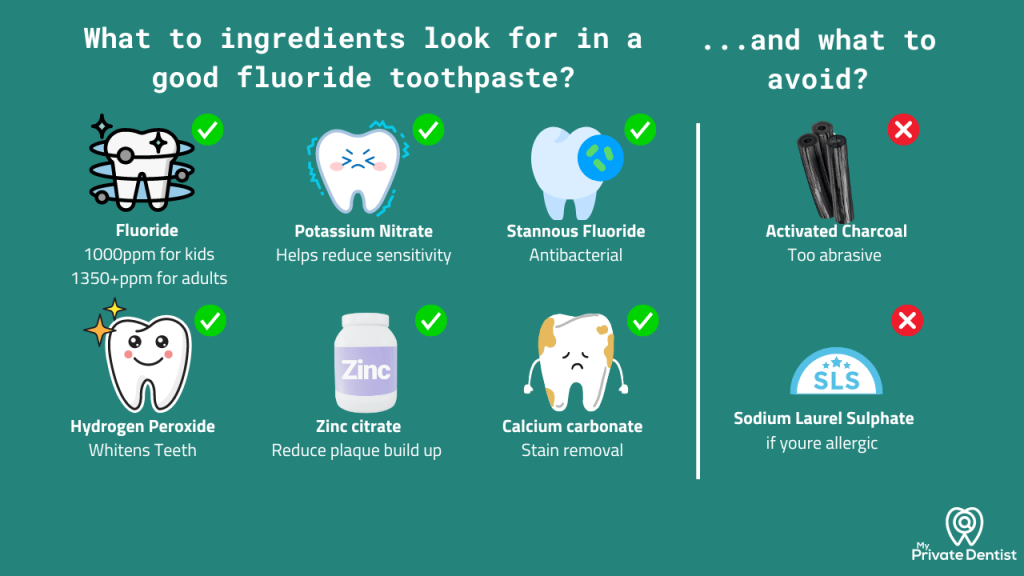
Fluoride is the most important ingredient to look for in toothpaste, as it helps prevent tooth decay by strengthening the enamel and making teeth more resistant to acid attacks from plaque bacteria and sugars in the mouth.
Potassium nitrate is often included to help reduce tooth sensitivity by calming the nerves in the teeth (7).
Stannous fluoride is another important fluoride compound that not only helps prevent cavities but also provides antibacterial action to protect against gingivitis.
Arginine is used to promote the remineralization of enamel and repair early signs of tooth decay.
Hydrogen peroxide and brighteners are added for whitening properties, while charcoal and sodium bicarbonate act as mild abrasives for stain removal.
Hydrated silica and calcium carbonate are also abrasives that help to remove plaque and surface stains.
Artificial sweeteners and flavor providers enhance the taste of the toothpaste without promoting tooth decay.
Sodium lauryl sulfate (SLS) and alternatives are included as foaming agents and surfactants to help distribute the toothpaste throughout the mouth. Some patients may have sensitivity to SLS, and may need to avoid this ingredient.
Thickeners like cellulose gum, carrageenan, and xanthan gum give toothpaste its texture and consistency.
Sodium hydroxide is used as a pH neutralizer to maintain the stability of the toothpaste.
Humectants such as sorbitol, glycerol, glycerin, and propylene glycol are added to prevent the toothpaste from drying out.
Tin oxide and titanium dioxide are colorants that also provide antibacterial and whitening effects.
Zinc is included for its antibacterial properties and as a replacement for triclosan, an ingredient that has been banned in some products due to environmental concerns.
Fluoride-free toothpaste
Using fluoride-free toothpaste will not provide the same level of protection against tooth decay and enamel strengthening as fluoride-containing toothpaste. Fluoride is a key ingredient in preventing tooth decay and promoting oral health. Therefore, opting for fluoride-free toothpaste could potentially increase the risk of developing cavities and other dental issues.
High Fluoride toothpaste
If you believe that high-strength fluoride may be necessary as you have defects in your teeth or a high decay rate. it’s advisable to consult a dentist for personalised guidance and recommendations.
Children 8 and over can be prescribed 2800ppm NaF, and over 16s can have 5000ppm Naf toothpastes (4).
Texture and Application
Fluoride toothpaste is available in various forms such as gel and paste, each offering a different texture and application method. Gel toothpaste provides a runny consistency, while paste toothpaste tends to be bitty. Additionally, toothpaste tablets and pumps offer alternative options for ease of application and use.
Flavours
Fluoride toothpaste comes in various flavors, offering options such as mint, flavor-free, and fruity, catering to different preferences. Some individuals may find mint flavors refreshing, while others may prefer flavor-free options to avoid sensory overload.
Sensitivities
For individuals with sensitivities, some fluoride toothpaste options are formulated without SLS (sodium lauryl sulfate), addressing concerns related to allergies or sensitivities to this ingredient. These alternatives provide suitable options for individuals seeking toothpaste that aligns with their specific sensitivities or allergies.
Sustainability
When it comes to sustainability, there is a growing consideration for eco-friendly options and sustainable packaging in fluoride toothpaste products. Toothpaste tablets, for instance, are gaining attention as an environmentally friendly alternative. For more information on this topic, explore our article on the Best Toothpaste Tablets.
How to Use Fluoride Toothpaste
Using fluoride toothpaste effectively involves a step-by-step approach to ensure optimal oral hygiene. Here’s a guide for effective brushing with fluoride toothpaste and tips for maximizing its benefits:
- Apply a pea-sized amount of fluoride toothpaste to a soft-bristled toothbrush.
- Hold the toothbrush at a 45-degree angle to the gums and gently brush the outer surfaces of the teeth using short, back-and-forth strokes.
- Brush the inner surfaces of the teeth and gums using the same technique.
- Clean the chewing surfaces of the teeth with a gentle scrubbing motion.
- Brush the tongue to remove bacteria and freshen breath.
- Spit out the excess toothpaste but avoid rinsing with water immediately to allow the fluoride to remain on the teeth for a longer period.
To maximize the benefits of fluoride toothpaste, it’s important to brush for at least two minutes, covering all tooth surfaces, and to brush at least twice a day, ideally after meals. Additionally, regular dental check-ups and professional cleanings complement the use of fluoride toothpaste for maintaining optimal oral health.
Why Trust Us
You can trust us thanks to the extensive credentials and expertise of our review team, which comprises highly qualified professionals with a wealth of experience in the dental and oral care field, including dentists, dental hygienists, and oral health experts.
Our review process is transparent, thorough, and meticulously conducted, adhering to strict guidelines and standards to ensure the accuracy and reliability of the information we provide. Each review is carefully vetted and verified by our team of experts to guarantee that our recommendations are trustworthy and up-to-date, empowering individuals to make informed decisions about their oral health.
Frequently Asked Questions (FAQs)
Q: Is fluoride safe to use in toothpaste?
A: Yes, fluoride is safe to use in toothpaste. It has been clinically proven to strengthen enamel and prevent cavities. While high levels of fluoride can be toxic if swallowed, the levels found in toothpaste are safe for use as directed.
Q: What are the benefits of fluoride toothpaste?
A: Fluoride toothpaste helps prevent tooth decay by strengthening enamel and making teeth more resistant to acid attacks from plaque bacteria and sugars in the mouth. It also aids in the remineralization of enamel and can help repair early signs of tooth decay.
Q: Are there specific fluoride toothpastes for different dental needs?
A: Yes, there are fluoride toothpastes designed for specific dental needs such as sensitivity, whitening, and for children. These variations cater to different oral health concerns while still providing the benefits of fluoride.
Q: Are there alternatives to fluoride toothpaste?
A: While fluoride toothpaste is highly recommended for its oral health benefits, there are fluoride-free toothpaste options available. However, it’s important to note that fluoride is a key ingredient in preventing tooth decay and promoting oral health.
Q: How should fluoride toothpaste be used for effective brushing?
A: It is recommended to brush with fluoride toothpaste at least twice a day, ideally after meals. Using a pea-sized amount of toothpaste and brushing for at least two minutes can help maximize the benefits of fluoride toothpaste.
Additional Oral Care Tips
In addition to using fluoride toothpaste, here are some oral care tips for preventing tooth decay and maintaining good oral hygiene:
- Brush your teeth at least twice a day, ideally after meals, using fluoride toothpaste. Be sure to brush for at least two minutes to ensure thorough cleaning.
- Floss daily to remove plaque and food particles from between your teeth and along the gumline.
- Limit sugary and acidic foods and beverages, as they can contribute to tooth decay.
- Maintain a balanced diet rich in fruits, vegetables, and dairy products, which can help promote good oral health.
- Drink plenty of water, as it helps rinse away food particles and bacteria from your mouth.
- Avoid tobacco products, as they can lead to oral health problems such as gum disease and oral cancer.
- Visit your dentist regularly for check-ups and professional cleanings. Dental check-ups are essential for detecting and addressing oral health issues early on
By following these tips and prioritizing regular dental check-ups, you can maintain optimal oral hygiene and reduce the risk of tooth decay and other dental problems.
Our Verdict
In conclusion, it’s essential to prioritize the use of fluoride toothpaste for optimal oral health. Our top picks for fluoride toothpaste cater to various dental needs, such as sensitivity, whitening, and kids oral care.
Using Oral-B Pro Expert Clean Mint Toothpaste as part of your daily oral hygiene routine to strengthen enamel, prevent tooth decay, and maintain overall oral health. For sensitive teeth Sensodyne Repair & Protect Toothpaste will relieve symptoms as well as providing protection from decay.
When selecting the best fluoride toothpaste for specific dental needs, it’s essential to consider seeking advice from a dentist to ensure personalized recommendations. Consulting with a dentist can provide tailored guidance on the most suitable fluoride toothpaste based on individual oral health requirements.
If you are in need of a dentist, we recommend finding a qualified dental professional to address your specific dental needs.









